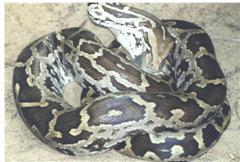Python - Indian
Scientific Name: Python molurus molurus
Thu, 17th April, 2025 - 9:44 am GMT
Sponsor Ads:

Alternative Name
Scientific Name: Python molurus molurusBasic Info
A large snake, the Indian Python can reach over 20 feet (6m) in length, however, the average length of the Indian Python is about 13 feet (4m). Paler than the Burmese Python, the Indian Python is usually a pale gray or tan color. They have a pattern of yellow-edged brown blotches on their backs. The Indian Python's head is long and triangular and has an arrow-shaped design on the top. This design, which always points forward, is the main distinguishing feature between the Indian Python and the similarly marked Reticulated Python that is found in the same region. Indian Pythons also have a blunt snout.
Health
Breeding Indian Pythons are oviparous, meaning they lay eggs instead of giving birth to live young. This species of snake is quite prolific, with clutches of between 25 and 50 eggs common. The female lays her eggs about three months after copulation. After laying the eggs, she wraps herself around the nest and incubates the eggs by twitching her muscles, warming up her body temperature. The eggs hatch after about 100 days, during which the female rarely leaves the nest. She generally fasts during this time and leaves the nest only to drink.Habitat
They also live in forests. Wherever the Python lives, they are always near water.Behavior
The Indian Python is a close relative to the Burmese Python, also a native of India. Although this animal is rarely bred in captivity, as a pet it can become quite docile if handled regularly. The Indian Python is comfortable in a variety of habitats and will spend its time in trees, traveling on the ground, or swimming in still water. The Indian Python usually feeds on small to medium sized animals, usually mammals about the size of a house cat, although they are capable of taking down much larger animals, such as wild boar. Indian Pythons are useful to humans because they rid urban areas of pets such as mice and rats. Found primarily in India and Pakistan, the Indian Python's numbers are decreasing rapidly. They are one of the preferred sources of skin for wallets, belts, boots, and more items. While once quite common, because of predation by humans for their skins and meat, as well as for medicinal properties some cultures feel the Python has, the Indian Python is now an endangered animal. Another reason for their decline is the destruction of their native habitat for development because of population expansion of humans. Furthermore, Indian Pythons are often killed by humans, who because of their large size consider the snakes a threat.Origin
Indo-PacificHistory
The Indian Python is usually found on rocky hillsides or scrubland.Common Foods
mice and ratsSponsor Ads:
"In theory, there is no difference between theory and practice. In practice, there is." -- Yogi Berra
Python - Indian
Coded by: BGID® | ALL RIGHTS RESERVED Copyright © 2000-2025
Disclaimer | Privacy | Report Errors / Contact | Credits








 Preparing For China. China is growing their military. China Military Technology - can it keep up with the US?
Preparing For China. China is growing their military. China Military Technology - can it keep up with the US?  versus
versus 

 versus
versus 
 This Thread is about the North Korean Military itself - the kind of army, navy, and air force they have.
This Thread is about the North Korean Military itself - the kind of army, navy, and air force they have. 
 versus
versus 
 versus
versus  versus
versus